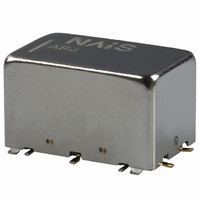ARJ2012 Panasonic Electric Works, ARJ2012 Datasheet - Page 4

ARJ2012
Manufacturer Part Number
ARJ2012
Description
RELAY HIGH FREQ 12VDC PCB MNT
Manufacturer
Panasonic Electric Works
Series
ARJr
Datasheet
1.ARJ22A12.pdf
(5 pages)
Specifications of ARJ2012
Relay Type
RF
Circuit
DPDT (2 Form C)
Contact Rating @ Voltage
0.3A @ 30VDC
Coil Type
Standard
Coil Current
16.7mA
Coil Voltage
12VDC
Control On Voltage (max)
9 VDC
Control Off Voltage (min)
1.2 VDC
Mounting Type
Through Hole
Termination Style
PC Pin
Lead Free Status / RoHS Status
Lead free / RoHS Compliant
Other names
255-1460
Available stocks
Company
Part Number
Manufacturer
Quantity
Price
RJ (ARJ)
NOTES
1. Coil operating power
Pure DC current should be applied to the
coil. The wave form should be
rectangular. If it includes ripple, the ripple
factor should be less than 5%.
However, check it with the actual circuit
since the characteristics may be slightly
different. The nominal operating voltage
should be applied to the coil for more
than 20 ms to set/reset the latching type
relay.
2. Coil connection
When connecting coils, refer to the wiring
diagram to prevent mis-operation or
malfunction.
3. External magnetic field
Since RJ relays are highly sensitive
polarized relays, their characteristics will
be affected by a strong external magnetic
field. Avoid using the relay under that
condition.
4. Cleaning
For automatic cleaning, the boiling
method is recommended. Avoid
ultrasonic cleaning which subjects the
relays to high frequency vibrations, which
may cause the contacts to stick.
It is recommended that alcoholic solvents
be used.
5. Tape and reel packing
1) Tape dimensions
2) Dimensions of plastic reel
X type
Z type
.079
2.0
RJ relay
±0.5
±.020
.059
1.5
+0.1
+.004
0
0
dia.
dia.
Relay polarity bar
21
.827
.370
Tape coming out direction
9.4
13
.512
±0.8
±.031
±0.2
(General tolerance: ±0.1 ±.004)
dia.
±.008
16.0
.630
dia.
dia.
24.4
.961
dia.
+2.0
+.079
0
0
2.0
.079
4.0
.157
14.4
.567
.945±.012
24.0±0.3
1.75
.069
80
3.150
11.5
.453
2.0
.079
±1
.016
±0.2
dia.
0.4
±.008
380
14.961
±.039
±2
dia.
dia.
±.079
8.8
.346
8.5
.335
All Rights Reserved © COPYRIGHT Panasonic Electric Works Co., Ltd.
dia.
6. Conditions for operation, transport
and storage conditions
1) Ambient temperature, humidity, and
atmospheric pressure during usage,
transport, and storage of the relay:
(1) Temperature:
–30 to +70°C
(However, tolerance range is –30 to
+60°C
carried as is.)
(2) Humidity: 5 to 85% RH
(Avoid freezing and condensation.)
The humidity range varies with the
temperature. Use within the range
indicated in the graph below.
(3) Atmospheric pressure: 86 to 106 kPa
Temperature and humidity range for
usage, transport, and storage:
2) Condensation
Condensation forms when there is a
sudden change in temperature under
high temperature and high humidity
conditions. Condensation will cause
deterioration of the relay insulation.
3) Freezing
Condensation or other moisture may
freeze on the relay when the temperature
is lower than 0°C 32°F. This causes
problems such as sticking of movable
parts or operational time lags.
4) Low temperature, low humidity
environments
The plastic becomes brittle if the relay is
exposed to a low temperature, low
humidity environment for long periods of
time.
5) Storage procedures for surface-mount
terminal types
Since the relay is very sensitive to
humidity, it is packed in humidity-free,
hermetically sealed packaging. When
storing the relay, be careful of the
following points:
(1) Be sure to use the relay immediately
after removing it from its sealed package.
(2) When storing the relay for long
periods of time after removing it from its
sealed package, we recommend using a
humidity-free bag with silica gel to
prevent subjecting the relay to humidity.
Furthermore, if the relay is solder
mounted when it has been subjected to
excessive humidity, cracks and leaks can
(Avoid freezing
when used at
temperatures
lower than
0°C 32°F)
–22 to +140°F
–30
–22
Tolerance range
85
–22 to +158°F
5
32
0
Temperature, °C
(Avoid
condensation
when used at
temperatures
higher than
0°C 32°F)
Humidity, %R.H.
if package is
°F
158
70
occur. Be sure to mount the relay under
the required mounting conditions.
7. Soldering
1) Surface-mount terminal
In case of automatic soldering, the
following conditions should be observed
(1) Position of measuring temperature
(2) IR (infrared reflow) soldering method
Temperature rise of relay itself may vary
according to the mounting level or the
heating method of reflow equipment.
Therefore, please set the temperature of
soldering portion of relay terminal and
the top surface of the relay case not to
exceed the above mentioned soldering
condition.
It is recommended to check the
temperature rise of each portion under
actual mounting condition before use.
2) Standard PC board terminal
Please meet the following conditions if
this relay is to be automatically soldered.
(1) Preheating: Max. 120°C
(terminal solder surface) for max. 120
seconds
(2) Soldering: Max. 260±5°C
max. 6 seconds
The effect on the relay depends on the
actual substrate used. Please verify the
substrate to be used.
Moisture-proof packaging enables RJ
relay’s standard PCB type capable for
reflow soldering.
Please contact us in the case of reflow
soldering considerations.
3) Hand soldering
Please meet the following conditions if
this relay is to be soldered by hand.
(1) Wattage: 30 to 60 W
(2) Tip temperature/time: 280 to 300°C
536 to 572°F
The effect on the relay depends on the
actual substrate used. Please verify the
substrate to be used.
4) Avoid high frequency cleaning since
this may adversely affect relay
characteristics. Use alcohol-based
cleaning solutions when cleaning relays.
T
T
T
1
2
3
= 150 to 180°C
= 230°C
= Within 250°C
Surface of PC board where relay is mounted.
T
T
T
3
2
1
446°F
for max. 5 seconds
and higher
302 to 356°F
482°F
t
1
t
t
1
2
t
2
= 60 to 120 sec.
= Within 30 sec.
248°F
500±9°F
for







